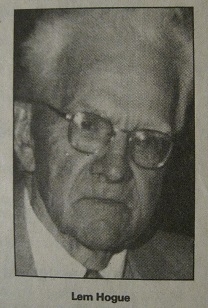WELLANDERS FONDLY REMEMBER LEM HOGUE
‘He was the type of man everyone enjoyed talking to’
[Welland Tribune, 7 July 1995]
By Richard Roik
One of Welland’s eldest civic boosters was buried yesterday.
Lemuel “Lem” Hogue died this week at the age of 91, but the mark he’s left behind as model citizen is one that will not soon be forgotten.
 “He has been one of the treasures of our city,” says Eleanor Clark, who first met Hogue through the local art club more than 20 years ago.
“He has been one of the treasures of our city,” says Eleanor Clark, who first met Hogue through the local art club more than 20 years ago.
In a life full of accomplishment, Hogue may best be remembered for the model he made of the Welland Canal. He would take it with him as he toured local schools helping youngsters to understand their hometown roots.
The model now belongs to the Welland Historical Museum, as do many of the tools and equipment from his almost 40 years as a blacksmith in the city.
“It’s an invaluable collection,” says museum curator Dorette Carter.
“He was in business during much of the building of the canal.”
A snapshot of Hogue in front of his downtown shop adorns the front of the museum’s brochure, and although Carter came here too late to really get to know him, she’s amazed by the presence he had in the city.
“I’ve met quite a variety of people who speak so glowingly of him,” Carter says.
Self-taught, Hogue enjoyed sharing what he learned-although he consistently steered clear of the spotlight in doing so.
For some ten years he was among the volunteers who, without fail, taught weekly art classes to the residents at Sunset Haven Home for the Aged.
“He was the type of man everyone enjoyed talking to,” says Carol Rapelje, a long- time volunteer at the home for the aged.
“He was interested in the residents as a friend.”
H also took his love of art to the physically and mentally challenged, and started a program at Niagara College for such special-needs students.
His tireless energy marvelled many. He was a talented painter, and astronomy buff and a wildlife enthusiast-among other things.
“He had a philosophy that whenever he met someone he would try to leave them laughing,” says Ken Sykes, who knew Hogue through their 50 years of faithful service at the First Baptist Church.”
“He said life’s too short for hard feelings,” Sykes adds.
Children were among those who especially took to him-perhaps because they recognized a man forever young at heart.
He and his wife, Betty, who died in 1984, were still camping in their final years together.
Even at age 80, he was taking courses, despite probably knowing more than his instructors. He explained his joie de vivre by noting that if you’re too old to learn you’re probably too old to live.”
“I just found him to be the most fascinating and fantastic person in the world,” says Clark.
He leaves behind five children, and a legacy we can all build on.
The world could use more Lem Hogues.
- Lemuel Victor Hogue was born in Wainfleet, the son of Michael and Margaret Hogue and had six brothers.
- He worked with his father at the Hogue Blacksmith Shop on Fraser Street for a number of years before moving to the maintenance department of Whiting Industries for some 15 years retiring in 1970.
- Died 2 July 1995 in his 92nd year.
 Subscribe..
Subscribe..